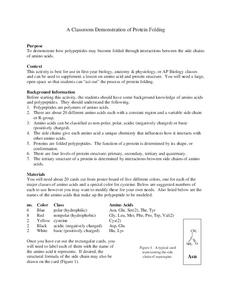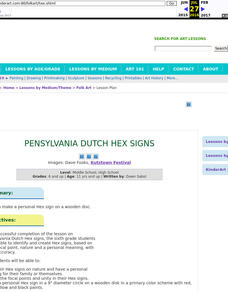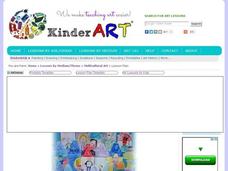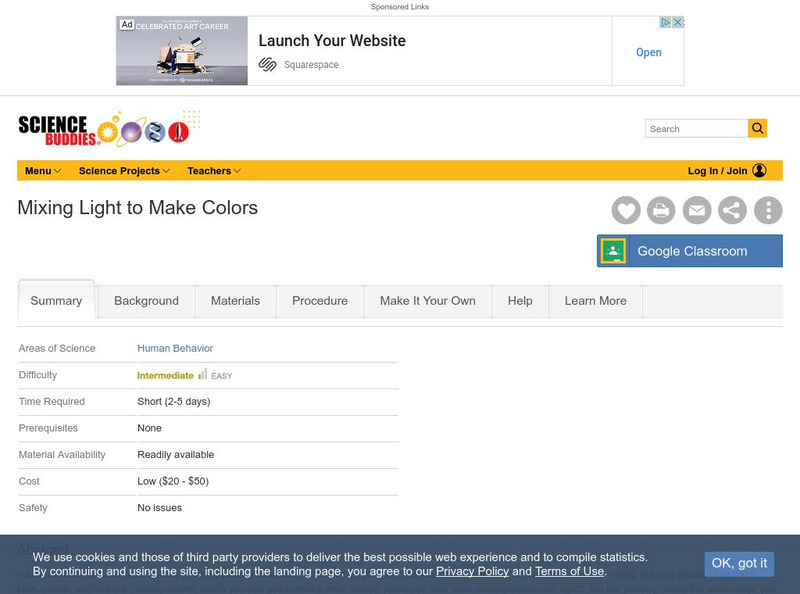Southwestern Medical Center
A Classroom Demonstration of Protein Folding
Does the mention of proteins and polypeptide relationships in your classroom result in mass confusion? Does the attempt to teach this important concept generate multiple questions and, at times, lead to a room filled with blank...
Curated OER
Mondrian Style Painting
Students create "Mondrian style" paintings in this 4th through 12th grade Art lesson. Emphasis is placed upon learning the styles and art techniques of Piet Mondrian and abstract art. The lesson includes a link to an interactive art...
Curated OER
Whole Number Sense
Students find the shapes that are asked of them out of a bunch of shapes. In this shapes lesson plan, students find a specific number of a specific shape with a specific size and color.
Curated OER
Quick and Easy Tie-Dye
Students create their own tie-dye shirts. In this visual arts lesson, students take shirts and wrap a rubber band around a few small areas. They dot these areas with sharpies and then blend them together with rubbing alcohol.
Curated OER
Line Up! Shape Up! Color the World!
Students explore the Elements of Art. In this art lesson, students read the book Katie Meets the Impressionists and brainstorm the different things that artists create. Students observe various elements of art such as line and color and...
Curated OER
Mondrian Inspired Abstract Art
Students explore the art of Piet Mondrian. In this abstract art lesson, students look at paintings by the Dutch painter and then follow the provided steps to create their own abstract art inspired by his works.
Curated OER
Pennsylvania Dutch Hex Signs
Sixth graders identify and create Hex signs, based on unity, focal point, nature and a personal meaning,
Curated OER
Pennsylvania Dutch Hex Signs
Sixth graders recreate Pennsylvania Dutch hex signs using pre-cut wood or cardboard, compass, acrylic or tempera paints, and paintbrushes in this 6th grade Art lesson. The lesson is an excellent idea for use in the Social Studies...
Curated OER
A Box Of Crayons
Students draw self-portraits on die-cut crayon patterns after hearing the poem "A Box of Crayons" in this Art lesson for the elementary classroom. The lesson is ideal for celebrating Martin Luther King Day and includes extra resource...
Curated OER
Buckets
Students practice their collecting and gathering skills while practicing recognizing colors and learning body contol.
Curated OER
Introduction to African Folklore
Students are read "Anansi the Spider" to begin their discussion on continents. Using a map, they locate the continent of Africa and the country of Ghana. They discover who the Ashanti people are and view examples of their artwork. They...
Curated OER
Check Out Lights and Shields with Beads
Students explore Ultraviolet detecting beads and conduct several investigations with them. In this investigative lesson students participate in an experiment to see the harmful effects of UV light and discuss their findings.
Curated OER
Mushroom
Students identify the different types of mushrooms. In this biology lesson, students explore different mushroom experiments they can do at home. They discuss ways to extend sliced mushrooms' shelf life.
Curated OER
Picture Frame
Students create their own picture frame. They use cardboard and macaroni for the frame. They put in the frame any picture they like from the class. They also make a stand for the frame.
Science Education Resource Center at Carleton College
Serc: Water Color Mixing
In this classroom lab activity, students will experiment with mixing the primary colors together: red, yellow, and blue, to determine what new colors may be observed.
Science Buddies
Science Buddies: Mixing Light to Make Colors
You know how to make new colors by mixing paint or crayons. For example, you get green by mixing yellow and blue, or orange by mixing red and yellow. With paint, blue, yellow, and red are primary colors, which you can use to make other...
Other
60 Second Science: Color Exploration I (Primary Colors Lesson Plan)
Discover what primary colors are and explore ways in which red, yellow, and blue can be mixed to create new colors.

















